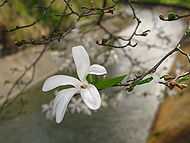Magnolia kobus
| Kobushi Magnolia | |
|---|---|
 | |
| Magnolia kobus var. borealis[1] | |
| Scientific classification | |
| Kingdom: | Plantae |
| (unranked): | Angiosperms |
| (unranked): | Magnoliids |
| Order: | Magnoliales |
| Family: | Magnoliaceae |
| Genus: | Magnolia |
| Species: | M. kobus |
| Binomial name | |
| Magnolia kobus DC. | |
Magnolia kobus, known as the Kobushi Magnolia, is a species of Magnolia native to Japan and occasionally cultivated in temperate areas.[2] It is a deciduous, small to tall tree which has a slow rate of growth but can reach 8–15 m (25–75 ft) in height and up to 10 m (35 ft) in spread.
Classification
Two varieties of Magnolia kobus are recognized by some sources, such as Hortus Third,[2] with var. borealis being a tree to 25 m (75 ft) high, with leaves to 15 cm (6 in) long, and var. kobus, a tree to 10 m (30 ft) high,with leaves to 10 cm (4 in) long.
M. kobus is classified within Magnolia subgenus Yulania.
The Kobushi magnolia is closely related to the star magnolia (Magnolia stellata), and some authorities consider the star magnolia to be a variety of M. kobus, M. kobus var. stellata.
Description
Magnolia kobus blooms in the early spring, bearing pleasantly fragrant white flowers with hints of pale pink about 10 cm (4 in) in diameter. The flowers are produced before the leaves, as with most members of Magnolia subgenus Yulania. Young trees do not flower.
The summer foliage of the Kobushi magnolia is dark green. Leaves have an obovate shape with a pointed tip, a smooth, or glabrous, leaf underside, and smooth, even edges. Leaves are 8–15 cm (3–6 in) long, in an alternating arrangement. In autumn, the leaves take on a yellow color and drop from the tree.

Magnolia kobus in flower, with a singular blossom in the foreground eclipsing an array of blossoms in the midground, over the backdrop of a waterway. Photographed in the Kantō region of Japan
The fruit of the Kobushi magnolia grows in groups of small red seeds. The groupings are one to three inches in size, and the seeds attract birds.
Older bark, such as that of the trunk, is grey-brown, while new stems are green with small brown spots. There is a strong odor to broken branches or twigs.
Culture
The Kobushi magnolia prefers full sun to partial shade, rich, well-drained soil, and is tolerant of acidic soils. It can be propagated either by seed or by cuttings.
References
- ↑ Cirrus Digital: Northern Japanese Magnolia Magnolia kobus
- ↑ 2.0 2.1 Bailey, Liberty Hyde, and Ethel Zoe Bailey, revised and expanded by the staff of the Liberty Hyde Bailey Hortorium (1976). Hortus Third: A Concise Dictionary of the Plants Cultivated in the United States and Canada. New York: MacMillan (and Collier MacMillan, London). pp. xiv + 1290.